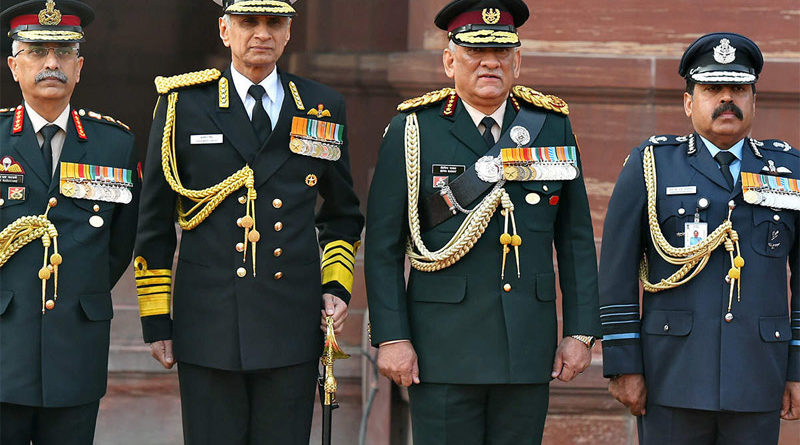India To Get Military Theatre Commands In 3 Years
Each Theatre Command would have an integral Air Force element and depending on the nature of the requirement, additional aircraft could be deployed. Preliminary discussions have been held between the Chief of Defence Staff and the three service chiefs
New Delhi: February 04, 2020
In three years from now, India will begin operationalising Military Commands which integrate the operations of the Army, Air Force and Navy, in the biggest restructuring in India’s military history.
In a select briefing, his first since he took over as India’s first Chief of Defence Staff, General Bipin Rawat said it was his goal to “develop the services as an armed force,” integrating capabilities, logistics and manpower within the new Military Commands. The goal is to bring down expenses, rationalise manpower and ensure that the armed forces fight as a cohesive unit.
While the number of commands has not been finalised, the Chief of Defence Staff is looking at the creation of proposals which would result in the creation of a Western Theatre Command, and at least one Northern Theatre Command. An Eastern Theatre Command would likely cover the border areas along the China frontier. The exact number of these Theatre Commands has still not been decided.
In addition to Commands which cover the land frontier against Pakistan and China, India would also have a Peninsula Command , an Air Defence Command and Space Command and a multi-service Logistics Command and Training Command.
Each Theatre Command would have an integral Air Force element and depending on the nature of the requirement, additional aircraft could be deployed.
Significant cost cutting in each Command would be achieved through common stores management, shared bases, maintenance stocks and through the utilisation of similar weapons. “In co-located stations, there is tremendous scope for the management of resources,” General Rawat said.
Preliminary discussions have been held between the Chief of Defence Staff and the three service chiefs with the CDS making it clear that it was his intention to begin the process of setting up the Commands within a finite period of time.
High-value military acquisitions, such as a proposed third aircraft carrier for Navy, “depends on how the economy progresses,” said General Rawat as this costly acquisition would have “an impact on the other services.” The Navy has fought for years for the government to sanction a third made-in-India carrier which would supplement INS Vikramaditya which is in service and INS Vikrant which enters trials soon before being inducted.
Similarly, for the Indian Air Force, the Chief of Defence Staff felt it is important to stagger the purchases of expensive fighter aircraft to ensure higher serviceability. India is looking closely at a deal to acquire 114 fighter aircraft for which a global tender is now under way. “Look at the maintenance cycle,” said General Rawat explaining that several newly acquired aircraft would need to be simultaneously serviced if they were acquired within a short period of time. This would mean that many of these assets would be simultaneously out of commission for a period of time. Instead, a system of staggered acquisitions for the Air Force would mean that at least some key operational platforms such as fighters, helicopters and drones would be available while others were being serviced.
Another cost cutting measure would be the indigenous manufacture of ammunition to a very high standard. “If ammunition has a shelf life of ten years, must you stock ammunition for twenty years?” asked the General, pointing out that it was “important to develop surge capacity” in quickly manufacturing ammunition if there was a crisis.
One of the most far reaching proposals, directly linked to the need to cut down on the whopping Rs 1.33 lakh crore pension budget of the Indian Armed forces would be to enable non-officer ranks to be employed till the age of 58. “One third of the Army, I believe, can work till the age of 58,” explained General Rawat. At the moment, soldiers in the armed forces are retired between the ages of 37 and 38 as opposed to officers who usually retire at 58. “The pension budget is huge. Is this sustainable?” said the Chief of Defence Staff.
Summing up his immediate priorities, the Chief of Defence Staff said he would try to “minimise wastages”, “prevent overstocking” supplies and if possible begin a possibility of “nil stocking” of supplies such as generators and auto components which are immediately available from commercial vendors. “Surplus and deficiencies need to be better managed. Jointmanship and optimisation is the need of the hour,” he said.
Courtesy: NDTV

